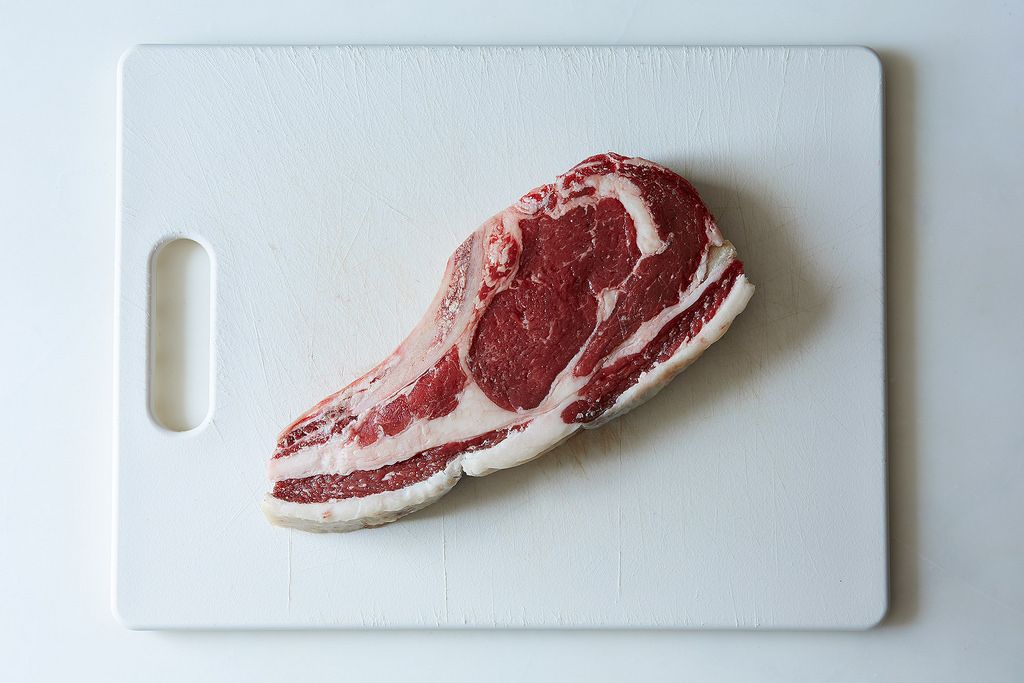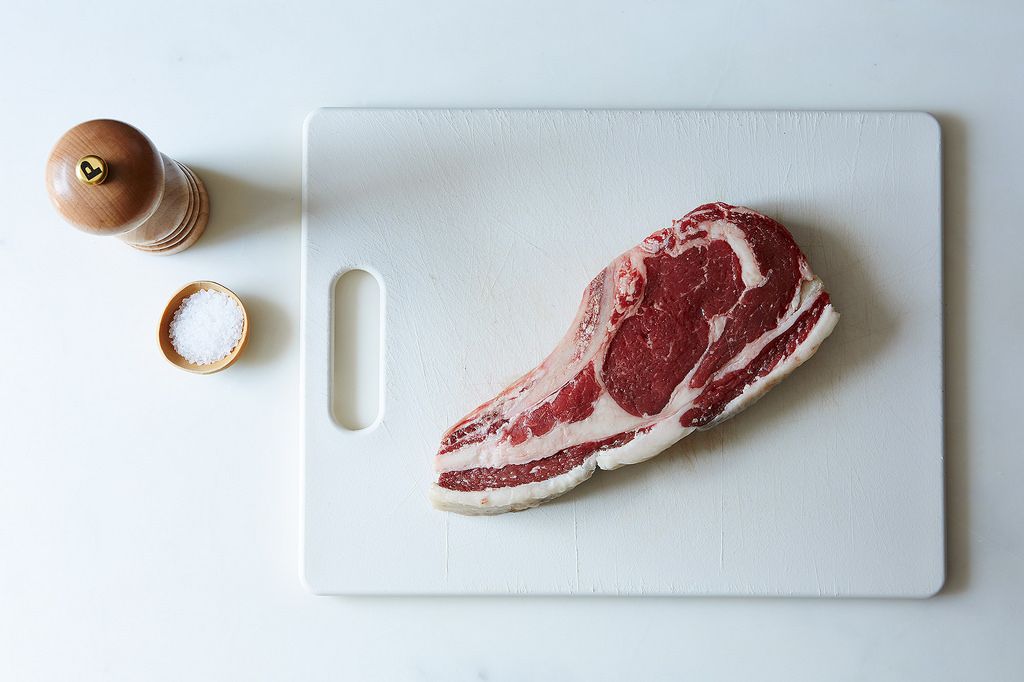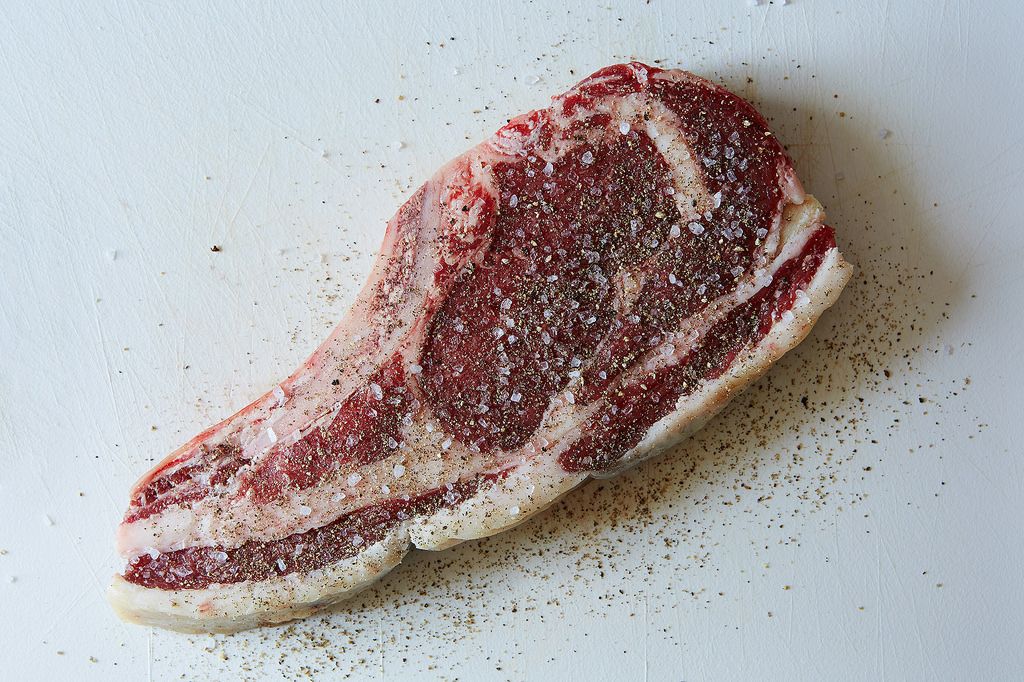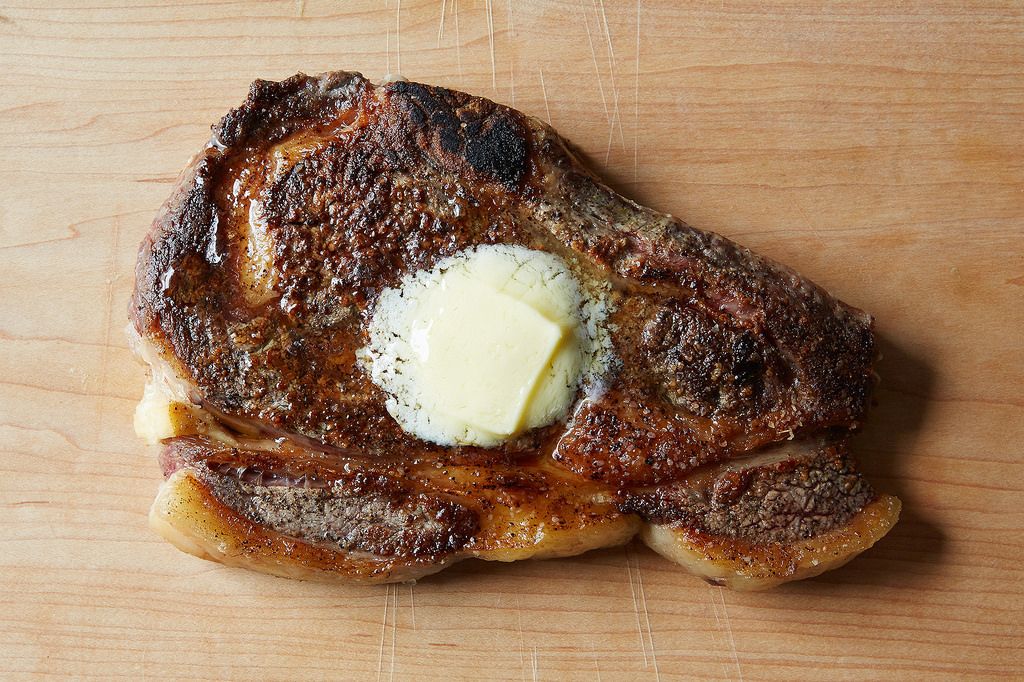Popular on Food52
Continue After Advertisement
25 Comments
MerryChristmas C.
January 24, 2017
I googled bone-in ribeye and this came up. My steak is precisely 1.5 inches thick and I took it out almost 2 hours before cooking, generously applied S&P. Preheated my cast iron skillet on high on my electric stove (with the requisite grape seed oil), placed the room temperature steak in the skillet and set the timer for 5 minutes, turned it over, set for another 5 minutes. When the timer went off I moved it to a warm platter, covered with aluminum foil and left it sit for a full 10 minutes. Unfortunately, what I ended up with wer perfectly cooked side dishes and a raw steak. I had to broil it for another 20 minutes to get it to a medium. PLEASE, Please, please, do not trust time in this recipe for a 1.5 inch thick bone-in ribeye. While everything but the time is accurate, this should have been a wonderful dinner but the extra time it takes to cook, beyond 5 minutes per side, has the potential to ruin a special dinner. It took 20 minutes under the broiler after the 10 minutes in a skillet and then there was the covered and waiting time (twice) and I am not an amateur cook by any stretch.
Jim#49
May 20, 2019
I’m thinking you did not heat up the iron pan long enough, as they take quite some time to get super hot. Just because it may sizzle water on it, doesn’t mean it’s hot enough. I even use my instant read thermometer on it to make sure.
Gino
August 15, 2015
Hope you can enlighten us one day about sirloin and filet steak and how the steaks becomes more marbled and what the influence is of feeding corn to the cows.
Roseanne S.
September 8, 2014
My son and I have come to love rib eye steaks. He said last time I served it, "Why would anyone buy any other kind of steak?" It's incredibly tender, but not in the same way as filet mignon, which we don't like, with better taste.
iWantMore
September 2, 2014
why do they say if you don't have 45 minutes to let it rest, don't do it at all.
"Because rib eyes are so huge, they need a good 45 minutes to an hour to come to room temperature, and absorb the salt you seasoned them with, so make sure you allot this time in your meal planning. If you don’t have 45 minutes to an hour, salt your rib eye and cook it right away -- just don’t let it sit out for an in-between amount of time.
"Because rib eyes are so huge, they need a good 45 minutes to an hour to come to room temperature, and absorb the salt you seasoned them with, so make sure you allot this time in your meal planning. If you don’t have 45 minutes to an hour, salt your rib eye and cook it right away -- just don’t let it sit out for an in-between amount of time.
hungryheart
March 20, 2015
It sounds like the technique is pretty much a dry brine: the salt draws out the moisture from the meat, and then the meat reabsorbs the liquid. Think about how a regular wet brine needs time for flavorful juices to penetrate meat-- a dry brine creates that moisture using the meat's own juices coaxed out with some salt, without added water/stock/liquid. A dry brine needs time to get the moisture out and back in (45-60 minutes, in this case), and if it was stopped before that, the meat would be likely just wet and salty on the outside.
Cara N.
March 20, 2015
I'm so sorry I didn't see this discussion before, but Hungryheart you are exactly right! You described it better than I could have, that's exactly it, thank you!
Jim#49
May 20, 2019
The less time heat can be applied to beef, the better. Long times can make it “livery” so always start at room temperature.
Ariette C.
August 8, 2014
Thanks for this. Rib Eye has laways been my favorite. It's a steak made to make tummies happy. lol
Ariette C.
July 30, 2014
Yeah Rib Eye is the top cut of beef for me too, reminds me of a steak I had in Hong Kong at Blue butcher - www.bluebutcher.com
Karen J.
July 21, 2014
I'm drooling, here, Cara!
Rib-eye has been my favorite cut of beef for as long as I can remember - thanks for these tips and "why to"s!
Rib-eye has been my favorite cut of beef for as long as I can remember - thanks for these tips and "why to"s!
Transcendancing
July 20, 2014
I would really love to hear more about the different cuts of steak and beef in general - especially with regard to the naming differences between the US and other places (I am in Australia so I am especially interested in cross referencing our names for stuff). Most of the scotch fillet I can buy easily doesn't have the bone in - is there a difference there again, or is it a cut I can really only get from my butcher? I've seen some delicious looking roasts labelled as rib eyes and I'd love to hear more about stuff to do with them that is wintery and delicious for cooking inside or in a slow cooker.
Brendan
August 17, 2014
Rib eye should be available from almost every butcher in Aus for around $26-28 kg. Most of what we buy here is grass fed, more flavoursome than grain yet not quite as tender. Scotch is essentially the same without the bone however is often a thinner cut with slightly less marbelling so likely from higher up (ribs 1-5). If you haven't got a cast iron griddle pan it plate, don't cook it until you do. Heat the plate in high, spray the rib eye with canola oil and place on. Leave on for approx 4-5 minutes (450g piece), turn 3 times cooking for same time, rest as mentioned and serve. Turn it not turn? You must turn as that forces the juices back into the meat so it remains gender through cooking. Unnecessary juices will depart during resting. Enjoy.
VOS
July 6, 2014
What is the best way to to grill short ribs?
Mr_Vittles
July 7, 2014
It really depends on the cut of short ribs. If you can buy Flanken-cut short ribs (like the ones you see at Korean Barbecue restaurants) those are good for grilling. Marinade them and grill as you would a steak. If you try and cook the traditionally cut short ribs, they will be a bit tough and chewy. When I cook the aforementioned Flanken-cut short ribs it always over direct, high heat flames. Flip every 30 seconds or so to avoid flare ups.
antonio W.
July 5, 2014
Good advice here. I'll have to try the grapeseed oil. That's a new one for me! Also, I would recommend to use a product called Grill Grate. I make NO money from them. I use these in steak cooking competition. It is one thing I never compete without! Thanks for the steak info!
Terry M.
July 4, 2014
Cook your rib eye on the wood burning grill using cast iron.....best of both worlds
Brant
April 28, 2017
Just got done cooking a ribeye on the grill. Used salt pepper with a little lemon pepper everything looked perfect when i took it off the grill. Even ehen i cut it it looked perfect! Had good flavor but it was the tuffest piece of meat i hsve hsd in years. To the point i gave it to my dogs. What could of went wrong?






See what other Food52 readers are saying.